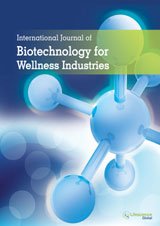IJBWI Abstracts
The Edible Mushroom Pleurotus spp.: II. Medicinal Values
|
|
|
Abstract: Mushrooms health benefit was recognized in the Orient from several thousand years ago as globally consumption and has third largest commercially production. The genus Pleurotus (oyster mushroom) is an organoleptic fast growing fungus which belongs to basidiomycota group. Although 70 species is discovered until now for this genus, but only few of them are available in market such as Pleurotus florida, P. sajor-caju and P. ostreatus. They have been used in human diet throughout the world due to their rich nutrients such as protein, fiber carbohydrate, minerals, vitamins and lipid. It should be noted that low amount calories, Sodium, fat and cholesterol is reported in this genus. Many pharmaceutical companies in the Far East and China are viewing the medicinal mushrooms as a rich source of innovative biomedical molecules. These molecules can be extracted from different part of oyster mushroom such as fruiting body, mycelia and culture broth. Mainly they are biopolymers including polysaccharides, proteins and nucleic acids as they are more variable to carry biological information. The medicinal properties of Pleurotus spp studied by several authors, as a result antitumor, immunomodulating, antiviral, antibacterial, antigenotoxic, antioxidant, anti-inflammatory, hypocholesterolamic, antihypertensive, antiinociceptive, anti-hyperglycaemic, anti-platelet-aggregating, antihepatoma, anti poliferative and antiatherosclerotic. In this chapter, biodivertsity of genus Pleurotus will be discussed regarding nutritional and bioactive compounds. Furthermore the prospective of oyster mushroom for therapeutic application and concept will be highlighted. Keywords: Pleurotus spp., medicinal mushrooms, mushrooms bioactive metabolites, immunomodulatory, antimicrobial. |
Antimicrobial, Antibiofilm and Immunomodulatory Activities of Lactobacillus rhamnosus and Lactobacillus gasseri against some Bacterial Pathogens
|
|
|
Abstract: In this study, two Lactobacillus (LAB) strains namely, Lactobacillus rhamnosus EMCC 1105 (L. rhamnosus) and Lactobacillus gasseri EMCC 1930 (L. gasseri) were tested for their antagonistic activities against Pseudomonas aeruginosa (P. aeruginosa), Escherichia coli (E. coli) and Staphylococcus aureus (S. aureus) which are known to be frequently implicated in biofilm infections. The acidic cell free culture supernatant (CFS) of 24 h and 48 h cultures of both LAB stains showed antimicrobial effects against the three pathogens in radial diffusion assay. These effects were abolished upon neutralization of CFS indicating that this effect was due to acids only. Both LAB strains could effectively inhibit the biofilm formation of the three test pathogens and largely replaced them on polystyrene surfaces as demonstrated by crystal violet staining, viable count and scanning electron microscopy. Both of the tested LAB strains could inhibit the protease productivity of S. aureus in 24 h and 48 h dual species-biofilms. The supernatant of 24 h-dual biofilms of P. aeruginosa with L. gasseri also showed a significantly lower protease activity compared to that of P. aeruginosa individual biofilm. Neither LAB strains affected phospholipase C production by the test pathogens when they co-exist during biofilm formation. The different preparations of LAB strains caused no significant change in the levels of gamma interferon expressed by peripheral blood mononuclear cells in response to stimulation by the test pathogens in vitro. In conclusion, L. gasseri and L. rhamnosus can be considered as promising tools for combating biofilm infections. Keywords: Probiotics, Lactobacillus rhamnosus, Lactobacillus gasseri, Biofilm, Antibiofilm, Gamma interferon. |






















